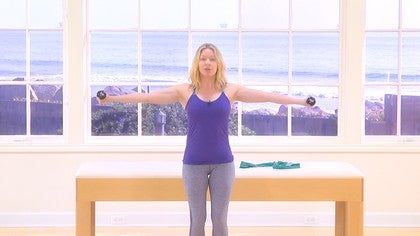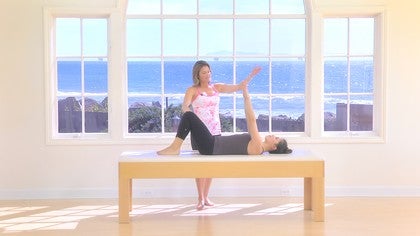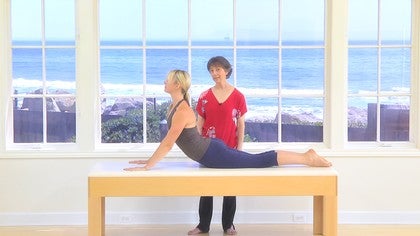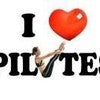Description
About This Video
Transcript
Read Full Transcript
Hi everyone, it's Amy and I have a short tutorial for us this afternoon. This today, wherever you are. And it's specifically about shoulders. And if you're at home and you've been taking some of the classes online, you've probably been hearing some general cues or a common cues of widen your collarbone, shoulder blades down, feel your lats, open your chest, things like that. So what I have for us is just a little extra kind of fine tuning and sensation work on what that is, what you can do and play with. I want you to get a theraband if you have one, you don't need one, but it's kind of fun what I have and maybe a set of small weights.
I've got two pounds. You could use one or two or no, no weights either. Okay. So just a real quick review. This is more for some beginners out there who are watching, uh, if we talk about our shoulders in general, and I'm going to actually go a little specific and talk about the shoulder blades, which are the bones on the back of the rib cage. They have kind of some motion that we can do with them. They can go up elevation, they can go down, which is the shoulder blades down thing, that's depression. So again, we have elevation and depression. Do that a few times and I want you to go maybe one more.
And then on the depression hold right there, but not not a 100% grip to feel like you're maybe 50% of of holding them down and see if you feel, and hopefully you do feel some strength or some tone, muscle tone change in the sides of the chest wall, right here are the sides of our back and that'll, those muscles actually continue going down from the armpits down the side of the ribs to the back of the waist. Those are aware of the breadth of our lat muscles are. So those that are big muscles on our back that help and really significantly help bring the shoulder blades down the back. That's the cue. But as you're practicing and getting more familiar with these sensations, go about 50% of the effort, you know, if you feel like you're really death gripping. And pulling down. Try to minimize that because that's not really natural and it might impinge some larger range motions in your arms later and some of times you might have, you might be training a lockdown on that. So maybe half, 50% okay, so again, we've got elevation, depression.
We also have if the shoulder blades as they come forward or I'm going to just do it this way, they're moving forward. That's a protraction and retraction is the shoulder blades moving back and together. So they're going to be going forward and around the rib cage and their shoulder blades going back and around the rib cage. So if I were the re the shoulder blades here, my hands, they're coming around your ribs in the front and around the back of the ribs. So they, they, they slide really, they glide. We want to come forward and back.
All right, so let's go up and down or elevation depression again, we are going about 50% effort here. Nothing too, too extreme. And then front and back. All right, so the shoulder blades really is there on the back of the body. Have all that motion to them and there's a lot of muscle in and around our shoulders and our back. So today's tutorial is going to educate that a little bit, but also then we'll give you exercises that can tone your shoulders and start to build strength in the shoulders. I'm a big believer in that for women. Okay, moving on. So I want you to take one hand and find your collarbone. I'm going to walk my fingertips along that collarbone right over to the end of it. So the side of the shoulder, I'm going to just do a light press of my fingers on that edge and try to sustain that being wide. Okay?
So in some of the exercises that we do in Pisces, we, we start to, you know, notice our shoulders creeping forward and it might bother the neck muscles. So this is that cue. Keep your collarbone in wide. Well how to do that, you have to use the muscles in your upper back specifically to hold that collarbone over there rather than letting the upper back sway your shoulder forward. Okay? So there it is. We've got a nice wide collarbone. Now I want to use this theraband and I'm going to hold a little open palm, put the end piece in there. And I want to take a, maybe the length of my forearm and all the way up to my arm to that edge of the collarbone again. So there are my fingers on my collarbone and I want you to hold your arm out with your palm facing me and your fingertips on the edge of that collarbone. And just for a moment, one of the other words you hear a lot in here is elongate.
I think you probably hear that a lot. We can elongate anywhere in our body. Really right now. I want you to think of elongating from these fingertips up here to these fingertips down there. And this elastic band is very, uh, useful. It's a good feedback. The elasticity of the band can also kind of be what your muscles are doing, the texture of the stretch, the elongation. Okay.
So just in doing that from these upper fingers on the shoulder, collarbone to your thumb may be now. All right, so just hold that. We're going to now add on a rotation of the arm and I want to have this whole arm do an internal rotation. So I'm going to start really thinking of it right up here, up near my collarbone, the upper arm bone rolling inward. Now I like to poke my thumb out because it helps me kind of steer my arm, but I want to rotate the arm but not have the collarbone join in. So there's two distinct things here. The collarbone is stable, the arm can spiral or rotate in.
Also add elongation of the the theraband. Okay, it should feel pretty good. And now let's rotate the arm outward and I'm spiraling it. Now I'm actually kind of bringing my pinky finger more up and to refer my fingered here. Pinky finger and thumb. So internally, rotating color, bay bone stays stable. Externally, rotating, elongating the theraband. Let's do a couple more. Turning in, turning out.
Eventually you do these kinds of exercises. You don't have to use the theraband. A great way to tone your shoulder muscles, your deltoids. Let's do one more and external. I'm just going to quickly shifts shoulders. So I'm putting it in the palm, finding my collarbone, walking my hand over to the edge of that collar bone, starting with my collarbone wide and back. Some is lifted and just hold the collarbone wide. Now if I take an internal rotation of the arm doing so without moving the collarbone and elongating the theraband, I'm stretching those muscles.
The internal rotators really are working. And now external lo, rotate them can point back, pinky finger up, stretch the thera-band. Endless turn in and turn out and turn in and turnout. We'll go one more in the collarbone stays stable or the collarbone could even be kind of rolling back a little bit as well. Okay, so without your theraband, take both arms out and mimic the same thing. So here's our thumb joint. Think thumb is up, collarbone is wide stable. Rotate the arm bones inward. Imagine that theraband is on your arms and elongate and rotate outward.
There's the theraband. You can even get that pinky finger up. Okay, two more times. So internally, rotating, elongating and externally rotating. Let's go one more and we're going to hold the external rotation, which is here. And feel the, again, the sides of your back right underneath your underarms, the side of the rib wall, and hopefully into your back musculature. Okay, so keep that sensation. This is that cue you're going to start to, you know, as you start doing more classes, collarbone wide, collarbone wide, that's what that means. It's wide, it's stable and it's back. The shoulders are not elevated, they're not too depressed, but they're more depressed. They're not too forward, and they're definitely not pinching. They're right on the back of the body, just nice and stable. All right, now add some hand weights to this. I'm going to do the same exercise, so now if we do some exercises to kind of build some aesthetic in the shoulders, let's turn in and turn out, turn in.
And as you do these turning in, turning out, let's start to raise them up shoulder level if you can. When the only go shoulder level, now it's great for summertime arms. It's getting summer with close to summer here in Santa Barbara Spring. Okay. And hopefully you're feeling your that the top, top of your arms, getting some workout and let's go maybe two more. Turning out, turning in, turning out, turning in, and then find a neutral position for me. That's my palms face up. My collar bone is wide. Let's do some bicep curls. Let's do 10 of them.
The objective here is that shoulder girdle, which includes that collar bone is stable so there isn't the elevation of the shoulder blades. You're not pinching down too hard. The shoulder blades are not for rid of your ribs. They're more on your back and any place else, five more you can exhale and so this is just two pounds of weight for each arm for me feels pretty good. You can spend 10 minutes a day doing this, two or three basic exercises to really tone and shape your shoulders. All right, and let's come down.
Now I'm going to stand up for the next one so that I can have some room behind me from my triceps. The back of the arms, it's the same thing. I'm going to bend my knees just a little bit. So if I open up and organize my collarbone and my shoulders and move the arms behind now, so I'm going to target and try to sensate the back of the fleshy part of the arm without disturbing that collarbone without making it go too wide, too narrow up or down and press back. You have 10 minutes a day. You can do three to five exercises to really shape your arms.
Let's go five more and press it comes our train press and three and four and five. All right, one more and that's going to be an up and down motion on the arms. I'm going to keep the knees a little bit then so I want to start to lifting my arms up and lowering my arms down. Now do five like that first. So knuckles to the ceiling. I'm in that external rotation here and then slightly internally rotating here and down and one more and down. Now reversing it. So keep the arms externally rotated as you raise them, turn them down, the palms down. As you lower palms up, it's more external rotation of arms. This is slight internal. Three more.
Stay aware, stay feeling the sides of your body, the sides of your back and the sides of your shoulders and your upper back unless you one more. So if you have five or 10 minutes a day, take a look at this tutorial a few more times. This is just a basic kind of glimmer on some thoughts about how you can work on your shoulders. And for those of you who have equipment at home and are taking a reformer classes, a lot of that work on your shoulders, as you know, is the weight work on the reformer and in all the strap work. So to be continued, maybe next time, a little longer. But um, thanks for joining in. I'll see you next time.
The Successful Beginner: Movement Breakdowns
Comments
Thank you.
You need to be a subscriber to post a comment.
Please Log In or Create an Account to start your free trial.



















